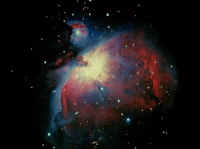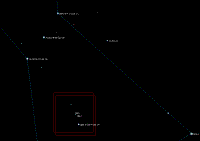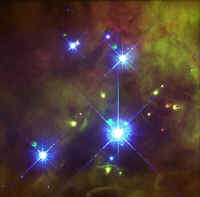M42 and M43 (diffuse nebulae in Orion)
420: M42 and M43 image
M42 and M43 comprise the Great Nebula in Orion, which is the most spectacular deep sky object of all. It’s safe to say that when Orion is up, few astronomers can resist taking at least a quick peek at it, no matter what their agenda is for that evening. I can happily spend entire observing sessions looking just at Orion, and I’m by no means alone. When you look at Orion, you’re looking literally at Creation, because Orion is the nearest and most easily observed “star factory”, where we can watch baby stars being born.
Like M44, Praesepe, and M45, the Pleiades, M42/43 were “gimme” objects for Messier, who needed four objects fast to fill out his catalog to 45 objects. He added M42/43 on March 4, 1769, the same day he added M44 and M45. I’ve always figured he was deeply ashamed of himself later for the cheap shot.
430: M42 and M43 overview
The Astronomical League rates M42 as an “Easy” object with 7X50 binoculars, which of course as a naked-eye object it is. They rate M43 as invisible in binoculars, although of course if you have M42 in your binocular you also have M43 in the same field of view. Like the Pleiades, M42/43 is a very easy object to find. As long as you can locate the constellation Orion, you shouldn’t have any problem finding M42 and M43. You don’t need the Telrad or your optical finder to locate M42 and M43, other than as a pointing aid. The Sword of Orion is a naked eye object at Bullington, and M42/M43 is the middle “star” in the sword.
440: The Trapezium
One
outstanding feature of M42 is The Trapezium, a small cluster of new stars. This
photograph is a Hubble image of the Trapezium region.

450: The Trapezium
The four brightest stars, designated A through D, are easy to resolve with any telescope at moderate power. The next two stars, E and F, are much dimmer at magnitude 11, and at three arcseconds or so are relatively close to A and C respectively. Although it wouldn’t be much of a problem to resolve the A-E pair and the C-F pair under normal conditions, the background nebulosity of M42 makes it much more difficult than it would be with a dark background.
In fact, the ability to resolve E and F depends upon the optical quality of your scope, how well the scope is collimated, and seeing conditions. Under good seeing conditions, I can sometimes resolve E at 90X in our 10” Dob, and nearly always resolve it at 150X or more. Although just looking at the numbers it appears that F should be no more difficult to resolve than E, in fact it’s quite a bit harder. Under perfect seeing conditions, it’s possible to resolve F with a superb 4” scope, but don’t be disappointed if you can’t. Seeing conditions at Bullington often don’t allow F to be resolved in even our 10” scope.


